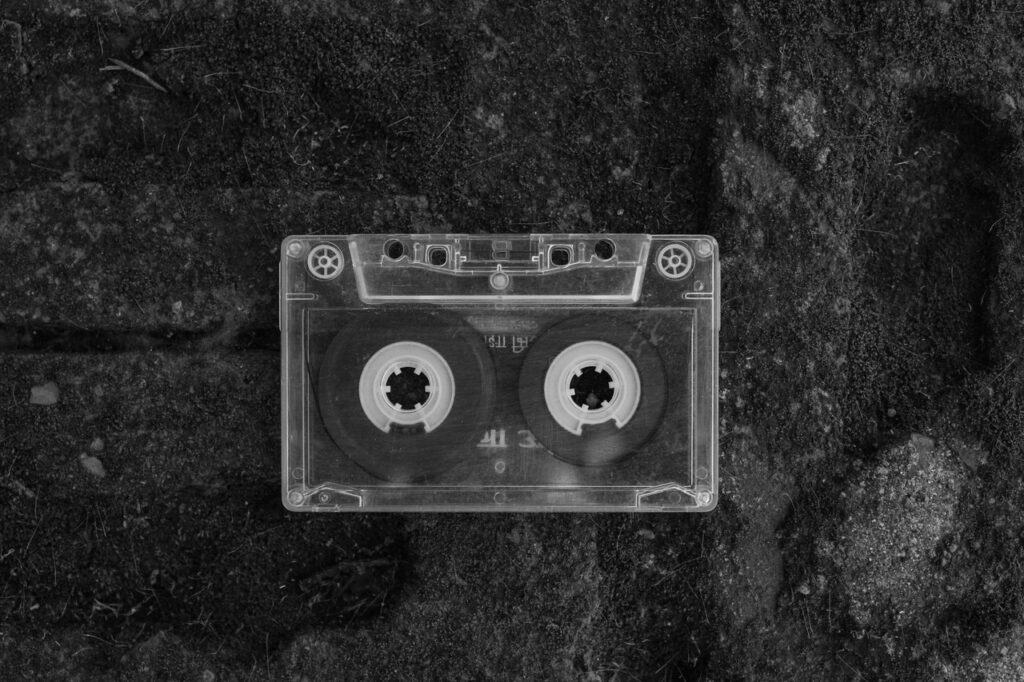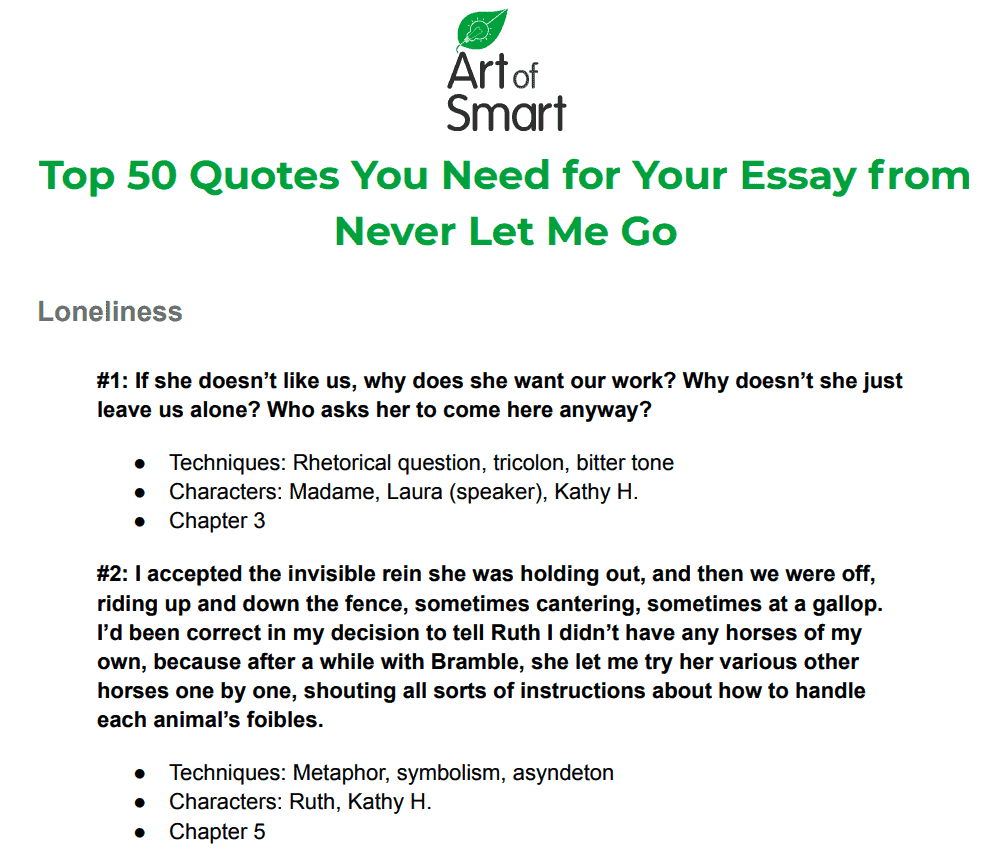Writing an essay on Never Let Me Go, but aren’t sure which quotes are important or worth analysing?
Look no further! We’ve got 50 quotes and 3 themes that will help you spark some great ideas.
To discover the top quotes you’ll want to remember, just scroll down!
Discover further insights on analysing of Never Let Me Go and more in this article!
Loneliness
Humanity Quotes from Never Let Me Go
Status Quo
Loneliness
#1: If she doesn’t like us, why does she want our work? Why doesn’t she just leave us alone? Who asks her to come here anyway?
- Techniques: Rhetorical question, tricolon, bitter tone
- Characters: Madame, Laura (speaker), Kathy H.
- Chapter 3
#2: I accepted the invisible rein she was holding out, and then we were off, riding up and down the fence, sometimes cantering, sometimes at a gallop. I’d been correct in my decision to tell Ruth I didn’t have any horses of my own, because after a while with Bramble, she let me try her various other horses one by one, shouting all sorts of instructions about how to handle each animal’s foibles.
- Techniques: Metaphor, symbolism, asyndeton
- Characters: Ruth, Kathy H.
- Chapter 5
#3: When it came down to it, though, I don’t recall our taking many practical steps towards defending Miss Geraldine; our activities always revolved around gathering more and more evidence concerning the plot itself.
- Techniques: Flashback, first-person plural
- Characters: Kathy H., Miss Geraldine
- Chapter 5
Analysis:
The narrator, Kathy, is reflecting on a time in her childhood when she and her friends were investigating a mysterious “plot” at their boarding school. Miss Geraldine is one of their teachers who seems to be involved in the plot. In this quote, Kathy is explaining that although they were concerned about Miss Geraldine’s safety, they didn’t take any practical steps to defend her.
Instead, their focus was on gathering evidence to understand the nature of the plot. This shows that the children were more interested in uncovering the truth about the plot than in protecting Miss Geraldine or themselves. This could be seen as a reflection of their lack of agency and independence, as they are not able to take direct action to change their circumstances or challenge the systems that control their lives.
#4: It should have been you two. I’m not pretending I didn’t always see that. Of course I did, as far back as I can remember. But I kept you apart. I’m not asking you to forgive me for that. That’s not what I’m after just now. What I want is for you to put it right. Put right what I messed up for you.
- Techniques: Truncated sentence, tautology, contrast
- Characters: Ruth (speaker), Kathy H., Tommy
- Chapter 20
#5: I keep thinking about this river somewhere, with the water moving really fast. And these two people in the water, trying to hold onto each other, holding on as hard as they can, but in the end it’s just too much. The current’s too strong. They’ve got to let go, drift apart. That’s how it is with us. It’s a shame, Kath, because we’ve loved each other all our lives. But in the end, we can’t stay together forever.
- Techniques: Motif, symbolism, natural imagery, metaphor, high modality
- Characters: Tommy (speaker), Kathy H.
- Chapter 23
#6: Sometimes I get so immersed in my own company, if I unexpectedly run into someone I know, it’s a bit of a shock and takes me a while to adjust.
- Techniques: First-person singular, confessional tone
- Characters: Kathy H.
- Chapter 18
Analysis:
The narrator, Kathy, is reflecting on her personality and the way she interacts with others. In this quote, she is describing how she often gets so lost in her own thoughts and company that it can be jarring when she unexpectedly runs into someone she knows.
The quote suggests that Kathy is introverted and may be socially awkward or uncomfortable in social situations. She is so used to being alone and lost in her own thoughts that when she suddenly has to interact with someone, it can be disorienting. The phrase “takes me a while to adjust” implies that she needs time to recalibrate and shift her focus from her internal world to the external world and the person she has encountered.
This quote highlights a theme of isolation and detachment in the novel. Kathy’s introspective nature and tendency to be lost in her own thoughts may be a coping mechanism to deal with the emotional and psychological challenges of her life. It also suggests a sense of disconnection and separation from others, as Kathy’s internal world takes precedence over her relationships with people around her. The quote also foreshadows some of the novel’s broader themes of identity, humanity, and the nature of existence.
#7: I half closed my eyes and imagined this was the spot where everything I’d ever lost since my childhood had washed up, and I was now standing here in front of it, and if I waited long enough, a tiny figure would appear on the horizon across the field and gradually get larger until I’d see it was Tommy, and he’d wave, and maybe even call.
- Techniques: Motif, imagery, metaphor
- Characters: Kathy H., Tommy
- Chapter 23
#8: “You say you’re sure? Sure that you’re in love? How can you know it? You think love is so simple?”
- Techniques: Rhetorical question, condescending tone
- Characters: Madame (speaker), Kathy H., Tommy
- Chapter 21
#9: Well… I really wanted to find it [the cassette tape] for you. And when it looked in the end like it wasn’t going to turn up, I just said to myself, one day I’ll go to Norfolk, and I’ll find it there for her.
- Techniques: Asyndeton, colloquial tone and rhythm, motif, symbolism
- Characters: Tommy (speaker), Kathy H.
- Chapter 15
#10: Well, Kathy, what you have to realize is that Tommy doesn’t see you like that. He really, really likes you, he thinks you’re really great. But I know he doesn’t see you like, you know, a proper girlfriend. Besides, you know how Tommy is. He can be fussy… Tommy doesn’t like girls who’ve been with… well, you know, with this person and that.
- Techniques: Euphemism, metonym
- Characters: Ruth (speaker), Kathy H., Tommy
- Chapter 16
#11: And so we stood together like that, at the top of that field, for what seemed like ages, not saying anything, just holding each other, while the wind kept blowing and blowing at us, tugging our clothes, and for a moment, it seemed like we were holding onto each other because that was the only way to stop us being swept away into the night.
- Techniques: Repetition, long sentence, asyndeton, juxtaposition
- Characters: Tommy, Kathy H.
- Chapter 22
#12: If you think about it, being dependent on each other to produce the stuff that might become your private treasures – that’s bound to do things to your relationships.
- Techniques: Metaphor, symbolism
- Characters: Kathy H.
- Chapter 2
#13: The first time you glimpse yourself through the eyes of a person like that, it’s a cold moment. It’s like walking past a mirror you’ve walked past every day of your life, and suddenly it shows you something else, something troubling and strange.
- Techniques: Cultural reference (to Lacan’s mirror stage), metaphor, stream of consciousness
- Characters: Kathy H.
- Chapter 3
Analysis:
In this quote, Kathy describes this experience as a “cold moment,” comparing it to seeing oneself in a mirror that suddenly reveals something unexpected and unsettling.
The quote suggests that the experience of seeing oneself through the eyes of an outsider can be jarring and disorienting, especially if one has lived in a closed community for much of one’s life. It can force one to see oneself in a new and potentially uncomfortable way, and can challenge one’s sense of identity and self-worth.
This quote highlights a theme of identity and self-awareness in the novel. Throughout the story, the characters grapple with questions of who they are and what their place is in the world. The quote suggests that seeing oneself through the eyes of others can be a powerful catalyst for self-reflection and growth, but it can also be a painful and disorienting experience. By acknowledging the difficulty of this process, the quote emphasises the importance of self-reflection and self-acceptance, even in the face of challenges or discomfort.
#14: Because somewhere underneath, a part of us stayed like that: fearful of the world around us, and no matter how much we despised ourselves for it–unable quite to let each other go.
- Techniques: Motif, contrast
- Characters: Kathy H.
- Chapter 10
#15: It’s an object, like a brooch or a ring, and especially now Ruth has gone, it’s become one of my most precious possessions.
- Techniques: Objectification, simile
- Characters: Kathy H., Ruth
- Chapter 6
#16: I think of my pile of old paperbacks, their pages gone wobbly, like they’d once belonged to the sea.
- Techniques: Symbolism, motif, asyndeton, alliteration
- Characters: Kathy H.
- Chapter 10
#17: Maybe Tommy and I were making a special effort to be nice to each other, but the time seemed to slip by in an almost carefree way.
- Techniques: Metaphor, fragmented phrases
- Characters: Kathy H., Tommy
- Chapter 23
Humanity Quotes from Never Let Me Go
#18: Well… The thing is, it might sound strange. It did to me at first. What she said was that if I didn’t want to be creative, if I really didn’t feel like it, that was perfectly all right. Nothing wrong with it, she said.
- Techniques: Contrasting language, colloquial tone
- Characters: Tommy, Kathy H.
- Chapter 2
#19: But now, in that gallery, the woman was too close, much closer than we’d ever really wanted. And the more we heard and looked at her, the less she seemed like Ruth.
- Techniques: Homodiegetic narration, simile
- Characters: Kathy H., Ruth
- Chapter 14
Analysis:
The speaker is Kathy, one of the main characters, who is reflecting on a visit she and her friends made to a gallery. In this quote, Kathy describes their reaction to an exhibit featuring a woman who looked and sounded like their friend Ruth. However, as they looked and listened more closely, the woman began to seem less and less like Ruth.
The quote suggests that the experience of seeing someone who looks and sounds like a familiar person can be disorienting and unsettling, especially if that person is presented in a strange or unfamiliar context. As the characters in the novel are clones who are raised in a highly controlled environment, encountering someone who looks and sounds like them but who is not a part of their community can be especially challenging.
This quote highlights a theme of identity and individuality in the novel. Throughout the story, the characters struggle with questions of what it means to be a person, and how to reconcile their own unique experiences and perspectives with the expectations placed on them by society. The quote suggests that the experience of encountering someone who looks and sounds like them but who is not a part of their community is a powerful reminder of their own individuality and humanity, and can challenge the assumptions and expectations that they have internalised about themselves and their place in the world.
#20: What he wanted was not just to hear about Hailsham, but to remember Hailsham, just like it had been his own childhood. He knew he was close to completing and so that’s what he was doing: getting me to describe things to him, so they’d really sink in, so that maybe during those sleepless nights, with the drugs and the paint and the exhaustion, the line would blur between what were my memories and what were his.
- Techniques: Repetition, asyndeton, consonance, imagery
- Characters: Kathy H.
- Chapter 1
#21: I froze in shock. Then within a second or two, I began to feel a new kind of alarm, because I could see there was something strange about the situation. The door was almost half open… but Madame hadn’t nearly come up to the threshold. She was out in the corridor, standing very still… And the odd thing was she was crying. It might even have been one of her sobs that had come through the song to jerk me out of me dream.
- Techniques: Foreshadowing, metaphor, motif
- Characters: Kathy H., Madame
- Chapter 6
#22: Memories, even your most precious ones, fade surprisingly quickly. But I don’t go along with that. The memories I value most, I don’t ever see them fading.
- Techniques: Juxtaposition, stream of consciousness
- Characters: Kathy H.
- Chapter 23
Analysis:
The speaker is Kathy, one of the main characters, who is reflecting on the nature of memories. In this quote, Kathy acknowledges that memories can fade over time, but she also suggests that there are some memories that she values so highly that she doesn’t believe they will ever fade.
The quote highlights the theme of memory and the role that memories play in shaping one’s sense of self and identity. As the characters in the novel are clones who have been raised in a highly controlled environment, memories take on a special significance for them. Memories are one of the few things that they can truly call their own, and they provide a link to their past and a sense of continuity in their lives.
By acknowledging that some memories are more precious than others, and that some memories may never fade, the quote suggests that memories are not all equal. Some memories have a special significance and are more enduring than others, and these memories may play a particularly important role in shaping one’s sense of self and identity.
Overall, the quote underscores the idea that memories are a vital part of what makes us who we are, and that they can play an important role in helping us to understand and navigate the world around us.
#23: We took away your art because we thought it would reveal your souls. Or to put it more finely, we did it to prove you had souls at all.
- Techniques: Biblical reference, epistrophe, first-person plural
- Characters: Miss Emily, Kathy H.
- Chapter 22
#24: And you didn’t want to do it in the fields even when it was warm enough, because you’d almost certainly discover afterwards you’d had an audience watching from the house passing round binoculars. In other words, for all the talk of sex being beautiful, we had the distinct impression we’d be in trouble if the guardians caught us at it.
- Techniques: Metaphor, contrast
- Characters: Kathy H.
- Chapter 8
#25: We all know it. We’re modeled from trash. Junkies, prostitutes, winos, tramps. Convicts, maybe, just so long as they aren’t psychos. That’s what we come from. We all know it, so why don’t we say it?
- Techniques: First-person plural, rhetorical question, asyndeton, metonym
- Characters: Ruth (speaker), Kathy H.
#26: It never occurred to me that our lives, until then so closely interwoven, could unravel and separate over a thing like that. But the fact was, I suppose, there were powerful tides tugging us apart by then, and it only needed something like that to finish the task.
- Techniques: Metaphor, imagery, metonym
- Characters: Kathy H.
- Chapter 14
Analysis:
The speaker is Kathy, one of the main characters, who is reflecting on a turning point in her relationship with her friend Ruth. In this quote, Kathy expresses her surprise that their close relationship could be destroyed by a seemingly trivial disagreement. She suggests that there were underlying forces pulling them apart, and the disagreement was simply the catalyst that allowed these forces to complete their work.
The quote highlights the theme of friendship and the ways in which relationships can be shaped by external circumstances. It also explores the idea of how small events or actions can have large and lasting consequences. In this case, a disagreement over a pencil case serves as the tipping point that brings to light the deeper, underlying tensions that were already pulling Kathy and Ruth apart.
The use of the metaphor of “powerful tides” suggests that the forces that were pulling Kathy and Ruth apart were natural and inexorable, like the movement of the ocean. The fact that these forces were beyond their control underscores the idea that our relationships with others are shaped by factors beyond our understanding or control.
Overall, the quote suggests that the ties that bind us to others are delicate and easily broken, and that even seemingly small things can have significant consequences. It also underscores the idea that relationships are shaped by both internal and external factors, and that we must be mindful of these forces if we hope to maintain strong and lasting connections with others.
#27: What made the tape so special for me was this one particular song: track number three, ‘Never Let Me Go’.
- Techniques: Motif, stream of consciousness
- Characters: Kathy H.
- Chapter 5
#28: The woods played on our imaginations the most after dark, in our dorms as we were trying to fall asleep. You almost thought then you could hear the wind rustling the branches, and talking about it seemed only to make things worse.
- Techniques: Imagery, second-person
- Characters: Kathy H.
- Chapter 5
#29: Ruth had been right: Madame was afraid of us. But she was afraid of us in the same way someone might be afraid of spiders.
- Techniques: Simile
- Characters: Ruth, Madame, Kathy. H
- Chapter 3
Analysis:
In this quote, Kathy is acknowledging that Ruth had been correct in her assessment that Madame was afraid of them. However, Kathy adds the comparison to spiders, which suggests that Madame’s fear was more about revulsion or aversion than anything else. Spiders are often seen as creepy or scary creatures, but they are generally not seen as threatening in the same way that, say, a lion or a bear might be.
By comparing Madame’s fear to the fear of spiders, Kathy is suggesting that Madame viewed the students as strange or otherworldly, but not necessarily dangerous. This is in keeping with the overall theme of the novel, which is about a society that sees the clones as less than human, but not necessarily evil or dangerous.
The quote also highlights the idea that fear is often rooted in ignorance or misunderstanding. Madame’s fear of the students is based on her lack of knowledge about them, and her inability to see them as individuals with their own thoughts and feelings. This is a recurring theme throughout the novel, which emphasises the importance of empathy and understanding in building meaningful relationships with others.
#30: How maybe, after the fourth donation, even if you’ve technically completed, you’re still conscious in some sort of way; how then you find there are more donations, plenty of them, on the other side of that line; how there are no more recovery centres, no carers, no friends; how there’s nothing to do except watch your remaining donations until they switch you off.
- Techniques: Euphemism, repetition
- Characters: Tommy, Kathy H.
- Chapter 23
Status Quo
#31: But then there came a point when I just stopped resisting. It had to do with this particular donor I had once, in my third year as a carer; it was his reaction when I mentioned I was from Hailsham.
- Techniques: Foreshadowing
- Characters: Kathy H.
- Chapter 1
#32: Afterwards, the others thought he’d meant to do it, but I was pretty sure it was unintentional. His arms were still flailing about, and he wasn’t to know I was about to put out my hand. Anyway, as he threw up his arm, he knocked my hand aside and hit the side of my face.
- Techniques: Imagery, metaphor, symbolism
- Characters: Tommy
- Chapter 1
#33: The gallery Tommy and I were discussing was something we’d all of us grown up with. Everyone talked about it as though it existed, though in truth none of us knew for sure that it did.
- Techniques: Contrast, foreshadowing
- Characters: Kathy H., Tommy
- Chapter 3
Analysis:
The gallery that Tommy and Kathy were discussing is a metaphor for a kind of unfulfilled desire or fantasy that many of the characters in the novel share. The gallery represents something that they all believe in and talk about, even though they have never seen it for themselves and are not entirely sure that it exists.
This idea of a shared, but ultimately unproven belief is central to the novel’s themes of memory and identity. The characters in “Never Let Me Go” are clones who have been raised in a closed, controlled environment, and have limited access to the outside world. As a result, much of their understanding of the world is based on second-hand information, rumours, and stories.
The fact that the gallery is something that everyone talks about, but no one has ever seen, highlights the power of shared beliefs and the importance of community in shaping our perceptions of the world. At the same time, it also suggests the limitations of these perceptions and the fragility of the beliefs that underpin them.
Overall, the quote underscores the novel’s themes of memory, identity, and the importance of human connection. It also highlights the ways in which our beliefs and perceptions of the world can be shaped by our social and cultural context.
#34: It’s not good that I smoked. It wasn’t good for me so I stopped it. But what you must understand is that for you, all of you, it’s much, much worse to smoke than it ever was for me. You’ve been told about it. You’re students. You’re… special.
- Techniques: Foreshadowing, euphemism, tricolon
- Characters: Miss Lucy
- Chapter 6
#35: The problem, as I see it, is that you’ve been told and not told. You’ve been told, but none of you really understand, and I dare say, some people are quite happy to leave it that way. But I’m not.
- Techniques: Repetition, fragmented sentences, metaphor
- Characters: Miss Lucy
- Chapter 7
#36: The fantasy never got beyond that – I didn’t let it – and though the tears rolled down my face, I wasn’t sobbing or out of control. I just waited a bit, then turned back to the car, to drive off to wherever it was I was supposed to be.
- Techniques: Fragmented sentences, imagery
- Characters: Kathy H., Tommy
- Chapter 23
#37: The point about Chrissie—and this applied to a lot of the veterans—was that for all her slightly patronizing manner towards us when we’d first arrived, she was awestruck about our being from Hailsham. It took me a long time to realize this.
- Techniques: Parataxis, foreshadowing
- Characters: Chrissie, Kathy H.
- Chapter 12
#38: You were different. I remember. You were never embarrassed about your collection and you kept it. I wish now I’d done that too.
- Techniques: Short truncated sentences, regretful and sentimental tone
- Characters: Ruth (speaker), Kathy H.
#39: Poor creatures. What did we do to you? With all our schemes and plans?
- Techniques: Dehumanisation, rhetorical question
- Characters: Madame, Kathy H.
- Chapter 11
#40: That was when I first understood, really understood, just how lucky we’d been – Tommy, Ruth, me, all the rest of us.
- Techniques: Foreshadowing, asyndeton
- Characters: Kathy H.
- Chapter 1
#41: Your lives are set out for you. You’ll become adults, then before you’re old, before you’re even middle-aged, you’ll start to donate your vital organs. That’s what each of you was created to do. You’re not like the actors you watch on your videos, you’re not even like me. You were brought into this world for a purpose, and your futures, all of them, have been decided.
- Techniques: Second-person, fragmented sentences, anaphora
- Characters: Miss Lucy
- Chapter 8
#42: We couldn’t understand how you could ever get like that. . . . I was thinking maybe the reason you used to get like that was because at some level you always knew.
- Techniques: Euphemism
- Characters: Kathy H., Tommy
- Chapter 22
#43: I saw a new world coming rapidly. More scientific, efficient, yes. More cures for the old sicknesses. Very good. But a harsh, cruel, world. And I saw a little girl, her eyes tightly closed, holding to her breast the old kind world, one that she knew in her heart could not remain, and she was holding it and pleading, never to let her go.
- Techniques: Contrast, imagery, motif
- Characters: Madame, Kathy H.
- Chapter 22
#44: that day Tommy and I found another copy of that lost tape of mine in a town on the Norfolk coast, we didn’t just think it pretty funny; we both felt deep down some tug, some old wish to believe again in something that was once close to our hearts
- Techniques: Motif, metaphor, first person plural, juxtaposition
- Characters: Kathy H., Tommy
- Chapter 6
#45: By then, of course, we all knew something I hadn’t known back then, which was that none of us could have babies.
- Techniques: Plain tone
- Characters: Kathy H.
- Chapter 6
Analysis:
The protagonist, Kathy, is reflecting on a time when she was younger and naively believed that having babies was a natural part of growing up. However, as the characters grew older, they learned that their purpose in life was not to have babies but to serve as organ donors, and they are not able to have children of their own.
The quote suggests a sense of inevitability and resignation. The characters have come to accept their fate, and this realisation changes the way they see the world. It also highlights the theme of mortality and the characters’ acceptance of their own mortality, as they know that they will be donors until they “complete” (die) after a set number of donations. The quote also emphasises the importance of knowledge and understanding, as the characters’ lives are shaped by the knowledge they have about their own fate.
#46: she holds this baby very close to her and walks around singing: “Baby, never let me go . . .” partly because she’s so happy, but also because she’s so afraid something will happen, that the baby will get ill or be taken away from her.
- Techniques: Imagery, contrast
- Characters: Kathy H.
- Chapter 6
#47: We certainly didn’t think much about our lives beyond the Cottages, or about who ran them, or how they fitted into the larger world.
- Techniques: Euphemism, tricolon
- Characters: Kathy H.
- Chapter 10
#48: You see, we were able to give you something, something which even now no one will ever take from you, and we were able to do that principally by sheltering you.
- Techniques: Juxtaposition, fragmented language
- Characters: Miss Emily, Kathy H.
- Chapter 22
#49: You need to remember that. If you’re to have decent lives, you have to know who you are and what lies ahead of you, every one of you.
- Techniques: Second-person, high modality, daunting tone
- Characters: Miss Lucy
- Chapter 7
Analysis:
She is telling her students, who are clones created for the purpose of donating their organs, that they need to understand their true identities and the fate that awaits them.
Miss Lucy is urging the students to face the reality of their situation and to not cling to false hopes or illusions. She believes that accepting their fate is necessary for them to have “decent lives,” as it will allow them to make the most of the time they have and to prepare themselves for what is to come. By acknowledging the truth, the students can confront their fears and anxieties, and find a sense of meaning and purpose in their lives, despite their short and tragic destinies.
#50: We’d been thinking about the deferrals, the theory about the Gallery, all of it, for so long – and now, suddenly, here we were. It was definitely a bit scary.
- Techniques: Parataxis, plain tone
- Characters: Kathy H., Tommy
- Chapter 20
On the hunt for quotes from other texts?
Check out our list of quotes for the following texts:
- The Merchant of Venice
- Jojo Rabbit
- Go Back To Where You Came From
- Frankenstein
- Lord of the Flies
- Blade Runner
- Hamlet
- Pride and Prejudice
- To Kill a Mockingbird
- The Great Gatsby
- The Curious Incident of the Dog in the Night-Time
- The Crucible
Are you looking for some extra help with your Never Let Me Go analysis of quotes?
We have an incredible team of English tutors and mentors!
We can help you master your analysis of Never Let Me Go by taking you through the summary, key characters, quotes and themes. We’ll also help you ace your upcoming English assessments with personalised lessons conducted one-on-one in your home or online!
We’ve supported over 8,000 students over the last 11 years, and on average our students score mark improvements of over 20%!
To find out more and get started with an inspirational English tutor and mentor, get in touch today or give us a ring on 1300 267 888!
Lynn Chen is a Content Writer at Art of Smart Education and is a Communication student at UTS with a major in Creative Writing. Lynn’s articles have been published in Vertigo, The Comma, and Shut Up and Go. In her spare time, she also writes poetry.







